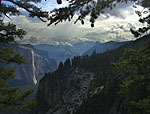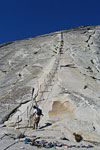Hiker
falls to his death from Half Dome cables![]() Story
and pictures © Larry Sullivan, 150mph.PlanetRambler.com
Story
and pictures © Larry Sullivan, 150mph.PlanetRambler.com
Saturday, June 13, 2009, Yosemite National Park, California
Conditions at Yosemite Valley and Half Dome throughout the day of June 13, 2009, from the Pohono Trail
Disclaimer
I hiked the south rim of Yosemite canyon all day on June 13, at or above
the same elevation as Half Dome and experienced the same weather conditions.
The information about the accident is from a couple I shared a campsite with, relayed to me
the next morning at camp. The emergency response information is from news sources. I have no first hand knowledge of the circumstances
that led to the tragedy, other than my observation of our shared weather
conditions and my experience climbing Half Dome, hiking in the Sierra
and the dangers associated with it. It's not my intention to assign blame
or liability to the victim nor the Park Service. I'm reporting what I was told as objectively as possible in
the interest of sharing information that may benefit future hikers. - LS
A young couple—my camp-mates
at Yosemite's Camp 4 backpackers campground—were descending the Half Dome
cables Saturday, June 13, 2009, when the climber directly above
them slipped and lost his grip.
|
Eric and Aydee of Berkeley, CA arrived the day before their Half Dome hike.This was their last big vacation before uprooting from the Bay Area and moving to Hawaii the next month. They were both experienced hikers, but this was Eric's first trip to Yosemite and their first time climbing Half Dome. The Friday night before was spent in good spirits around the communal campfire, getting acquainted, telling stories and playing guitar with fellow hikers and rock climbers who shared site #23 at Camp 4 - Yosemite Valley's legendary rock climbers campground.
A strenuous, all day hike
Getting up early is a requirement to complete the 11-12 hour roundtrip climb to the summit of Half Dome from the valley floor and back. It's a popular destination that's often the highlight of Yosemite hiking trips. The hike up the Mist Trail from Yosemite valley climbs alongside the rushing Merced River to two magnificent waterfalls, Vernal and Nevada, a mile apart. The trail is mostly steps blasted out of granite, which can be slippery from the mist of the falls. Above Nevada Falls, the trail winds along the Merced past the permit-only Little Yosemite Valley backpackers campground, where many Half Dome hikers over-night. From the campground, the trail climbs another 2 miles of steep switchbacks behind Half Dome to the granite summit of The Shoulder, aka Subdome, the large adjoining mountain north of Half Dome, where the cable steps begin. The last one quarter mile up The Shoulder is switchbacks over smooth, steep, unmarked granite and hikers arrive at the base of the cables exhausted. As with all Sierra peak hikes, it's wise to get off the summit before early afternoon clouds bring rainshowers. Afternoon rain had enveloped Halfdome both of the previous 2 days.
Changing weather
Saturday began sunny and hazy with high, thin clouds. The weather wasn't ideal for a summit attempt, but neither did it appear threatening. Clouds blew in and
|
Up and down the summit of Half Dome
Despite the less-than-perfect conditions, the popular destination had a sizeable crowd as it was one of the first weekends of the summer season. Not long after Eric and Aydee summited, the wind and rain picked up and visibility dropped. A queue to go down formed quickly and the couple waited for their turn to descend the slick, slippery granite face through the mist and fog to the relative safety of The Shoulder.
|
On a clear, dry day, it's easiest to climb down facing forward. Descending backwards, one must constantly look down to the next footstep and back up. As they descended, hikers below relayed information up the line on conditions and technique and the couple spoke with the victim several times. In these slippery conditions, the recommended technique was to grip the cable with the armpit as well as the hands. The couple expressed concern that the victim wasn't using the underarm brake method to the best advantage.
|
An unseated cable support
More than halfway down, an upright steel pole had come out of its drilled anchor hole and the heavy cable was unsupported and drooping against the rock. The thin metal strap that normally attached the 1 x 4 inch wooden cross piece footstep to the upright pole had broken or come loose, so there was no footstep at this area either. This upright had been in place and functioning correctly on their ascent. From below, information was relayed on the best method to get past the downed pole—switching to opposite, climbers-right cable or "up" cable. The Park Service puts the cables in this "down" position at the end of every season to minimize rockfall damage, yet intrepid hikers summit Half Dome year round without them functioning as intended.
The fatal slip
After Eric and Aydee carefully maneuvered past the unseated pole area, they heard the man having trouble at the danger point, saw him lose his grip and start to fall fast, watched him slide head first toward them, striking hard against a lower upright, too fast for a last, desperate grip. Then he careened down the rounded sloping granite and disappeared into a gully.
|
Shaken witnesses still have an ordeal getting down
Calls to 911 went out at approximately 3:40 pm and a helicopter with rescue crew was dispatched. News reports state 30-40 shaken hikers had to be helped down the cables and escorted down the mountain. But many made it back on their own. After coming to grips with the tragedy, they completed the harrowing descent on the cables to the relative safety of The Shoulder. Still ahead was the challenging climb down the slippery, unmarked granite face of The Shoulder to the dirt portion of the trail, and then five hours and 3500 feet of vertical back down the slippery granite steps of the Mist Trail to the valley below.
Some hikers at The Shoulder reported movement after the victim came to rest in a gully, and there was an impossibly slim hope that he could have survived, but it was not to be. Rescue crews determined the victim was deceased, but had to wait until daylight to transfer him to the valley. It was well after 1 am before the last hikers and rangers were back in the valley.
The couple attributed the fatal fall from the Half Dome cables to a combination of factors:
- The inclement weather including clouds and wet conditions. The steep granite, made smooth by years of footfalls, is doubly slippery when wet
- An upright steel post had come out of its mooring and made maneuvering past it especially challenging
- A thin steel strap that held the wooden cross-piece footrest had broken or come loose, making the crosspiece unusable as last ditch footrest
- The victim could have used the underarm brake technique to better advantage
- Given the conditions, they felt they shouldn't have been on the cables without harnesses and carabiners.
© 2009 Larry Sullivan. All rights reserved.
Visit my photo pages of California hikes:
• Climbing Half Dome under ideal conditions
• My hiking trip reports and photography home page












